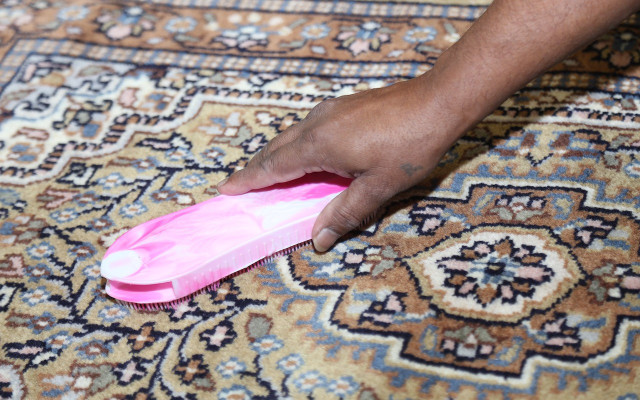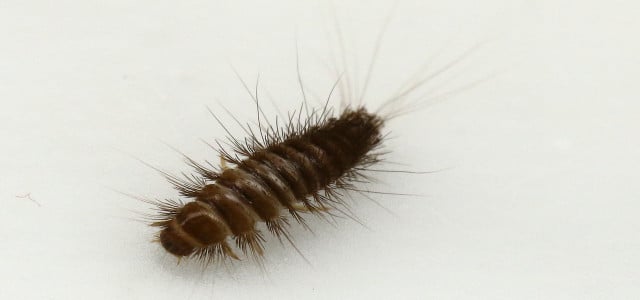Carpet beetles can be a pain, but you don’t necessarily have to use chemicals to kill them. If the tiny insects have taken up residence in the finely woven fabrics of your carpet, natural remedies can also help. We’ll show you how to get rid of carpet beetles naturally.
The carpet beetle is a member of the Dermestidae (or skin beetle) family. They are a scavenger that typically feeds on anything containing creatine and chitin. Carpet beetles eat through valuable carpets, clothing, and other textiles.
Carpet beetles have an oval body shape, and can grow up to five millimeters in length. Their shell is black with distinctive white, red, or even yellow spots. However, the hairy larvae are brownish-red and are covered in bristles.
Important: Allergy sufferers beware! Both the bristles and the skin of the larvae can cause allergic reactions such as hives, rashes, a runny nose, and watery eyes. The best way to alleviate the symptoms is to rid your home of all carpet beetles – using natural remedies.
Where Do Carpet Beetles Live?

In spring, the females lay up to 20 eggs in a place with food (creatine and chitin-containing substances). These include, as mentioned above:
- Carpets
- Skins
- Animal fibers
- Clothing
- Feathers
- Furs
Plant materials such as linen and cotton are excluded from this list, as carpet beetles do not like the fibers. Once the beetles are fully grown, there is no longer any danger, as they then feed only on flower pollen and nectar.
The problem are therefore mainly the larvae. Since they don’t like bright light, they prefer to burrow into dark places like the cracks between floorboards.
6 Natural Ways to Get Rid of Carpet Beetles Naturally
Skip the chemicals and try the following natural remedies to kill and get rid of carpet beetles:
- Search the affected area for the source of the infestation and vacuum joints, floorboards and gaps extensively.
- If necessary, sprinkle non-toxic diatomaceous earth on the areas to kill any remaining carpet beetles. Diatomaceous earth is a natural, powdery white dust that wears away at the insects protective layer, consequently drying them out. You can buy the powder from hardware stores, or on Amazon**.
- For heavy infestation, it’s best to steam clean your carpets and furniture. If you don’t already own a steam cleaner, check your local hardware store for equipment rentals.
- To get rid of carpet beetles, freeze infested clothing that you can’t wash on a hot or sanitary cycle for 72 hours and store them in an airtight container.
- If you store clothing in your closet based on the season, be sure to give the closet a good cleaning before you switch your clothing. Consider storing clothes you aren’t wearing in an airtight container or vacuum packed bag.
- In case of very heavy infestation, a pheromone trap helps. This natural remedy for carpet beetles works quickly, is hygienic and non-toxic. This is a trap with a sexual hormone that attracts the male animals and thereby prevents the spread of the larvae.
How to Prevent Infestations



To prevent carpet beetle infestation in the first place, follow these simple steps:
- Regularly clean your textiles.
- Brush, beat and clean your carpets and rugs thoroughly. This will help to remove dead insects and hair, which serve as food for carpet beetles.
- Empty the vacuum cleaner bag or filter to avoid breeding sites.
- For pet owners: remove pet hair from baskets and sleeping areas and wash textiles regularly.
- Seal gaps in flooring and walls to avoid providing a refuge for the beetles.
- Wash clothes and textiles preferably on a warm or hot setting. If there is a risk of infestation, you can spray the clothing with a neem oil based natural insect repellent.
- Cover windows with fly screens to block bugs from entering your home.
Last Resort for Killing Carpet Beetles
With a little luck and diligence, carpet beetles won’t have a chance to infest your carpets and clothing.
If you’ve tried everything and have been unsuccessful, call your local exterminator as a last resort. They will drive the beetles out of your home with pest control, however the insecticides used are anything but sustainable.
This article has been translated from German by Karen Stankiewicz. You can find the original here: Teppichkäfer: So wirst du ihn wieder los
Important Information regarding Health-related Topics.
** Links to retailers marked with ** or underlined orange are partially partner links: If you buy here, you actively support Utopia.org, because we will receive a small part of the sales proceeds. More info.Do you like this post?







